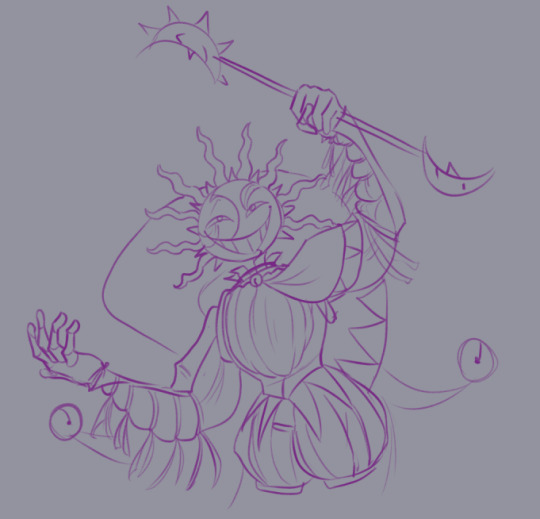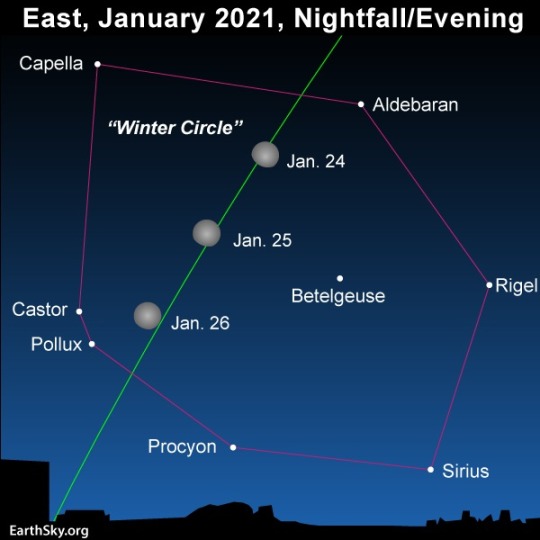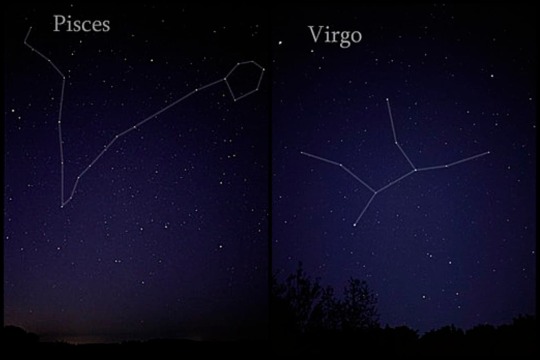#aldebaran (aster)
Text









gitm doodle dump be upon ye. with bonus aldebaran shoved in at the end. I've. been busy doodling X)
ghost in the machine / fool, sunspot, soleil @venomous-qwille
[Image descriptions in ALT]
#gitm#gitm au#ghost in the machine au#fnaf#fnaf au#fnaf daycare attendant#daycare au#sun fnaf#fnaf sun#fnaf eclipse#gitm fool#gitm sunspot#gitm soleil#CaelOS#oc#original#Aster#Aldebaran (aster)#doodle post#doodle dump#probably not the best idea to put an OC mixed with Also Rayed fnaf fan characters but i figured fuck it when else am i gonna post the silly#im genuinely just a bit bored i felt like posting what ive made for the past couple days
533 notes
·
View notes
Text

This Week's Sky at a Glance, January 26 – February 4
FRIDAY, JANUARY 26
Once it's nice and dark, spot the equilateral Winter Triangle in the southeast. Sparkly Sirius is its brightest and lowest star. Betelgeuse stands above Sirius by about two fists at arm's length. To the left of their midpoint is Procyon.
Can you discern their colors? Sirius (spectral type A0) is cold white, Betelgeuse (M2) is yellow-orange, and Procyon (F5) is very slightly on the yellowish side of white. Binoculars make star colors more evident.
As Saturday's dawn grows bright, Mercury and fainter Mars have a very difficult conjunction just above the southeast horizon as shown below. You'll need an open horizon in that direction and optical aid, maybe powerful aid.
SATURDAY, JANUARY 27
The Moon, two days past full, rises not long after the end of twilight. Once it's well up, spot Regulus to its upper right and Gamma Leonis a little farther to its upper left. These are the two brightest stars of Leo's Sickle.
SUNDAY, JANUARY 28
The biggest well-known asterism (informal star pattern) is the Winter Hexagon. It fills the sky toward the east and south these evenings.
Start with brilliant Sirius at its bottom. Going clockwise from there, march up through Procyon, Pollux and Castor, Menkalinan and Capella on high, over and down to Aldebaran, then to Rigel in Orion's foot, and back to Sirius. Betelgeuse shines inside the Hexagon, well off center.
The Hexagon is somewhat distended. But if you draw a line through its middle from Capella down to Sirius, the "Hexagon" is fairly symmetric with respect to that long axis.
Take the line from Aldebaran to Capella, turn it to go from Aldebaran to Betelgeuse instead, and the Winter Hexagon becomes the Heavenly G.
Yin Yang
Cosmic Polarity
Talon Abraxas
39 notes
·
View notes
Text

Elsewhere
The delectable names of harsh places:
Cilicia Aspera, Estremadura.
In that smooth wave of cello-sound, Mojave,
We hear no ill of brittle parch and glare.
So late October's pasture-fringe,
With aster-blur and ferns of toasted gold,
Invites to barrens where the crop to come
Is stone prized upward by the deepening freeze.
Speechless and cold the stars arise
On the small garden where we have dominion.
Yet in three tongues we speak of Taurus' name
And of Aldebaran and the Hyades,
Recalling what at best we know,
That there is beauty bleak and far from ours,
Great reaches where the Lord's delighting mind,
Though not inhuman, ponders other things.
By Richard Wilbur
32 notes
·
View notes
Text
I'm plotting a new AU!!!
I sure as hell hope that I don't accidentally copy someone else's :T
It's already similar / inspired by Aster (Rigel, Vega and Aldebaran) >~<
5 notes
·
View notes
Text









STARMAP OF MUSES — santa guadalupe edition.
A starmap is a celestial map that gives the positions and magnitudes of the stars. They are used to identify and locate constellations, stars, nebulae, galaxies, and planets. Celestial maps have been used for human navigation since time immemorial.
(insp)
✦ FOLLOW THE STARMAP.
Tiago Henrique McGowan is Fùěr (also known as Sigma Tauri) meaning Whisper, because this star is marking itself and stands alone in the Whisper asterism of the Net mansion. The Net mansion is one of the western mansions of the White Tiger, his representative animal.
Marcos Gabriel dos Santos is Sabik (also known Eta Ophiuchi), from the Arabic السابق al-sābiq "the preceding one". He's the love Auramere that came right before Tiago.
Helena Mariano is Antares (also known as Alpha Scorpii) meaning "rival to-Ares". Antares is the brightest star in the constellation of Scorpius. She was Hippolyta, queen of the Amazons, until she found out about the Red Cult's true intention and fought against them.
Caetana Nascimento is Alkafzah (also known as Kappa Ursae Majoris), from the Arabic القفزة al-qafzah "the leap". She's the youngest of her friendgroup, and even when things are hard, she has a lot of faith that things will get better.
Brandon Mastriani is Achernar (also known as Alpha Eri) meaning "End of the River". Achernar is the brightest star in the constellation of Eridanus. Considering his presumed death and water deity, some part of his personality really did die. After his return, he connected with the air deity and became the eye of a storm above the river he once was.
Harriet Coleman is Electra (also known as 17 Tauri). Named after one of the seven Pleiades, Electra is also the designation of a comet. By way of explanation for the fact that only six of the seven stars in the constellation were readily visible, it was said that Electra, unable to behold the destruction of Troy, hid her eyes, or turned away; or, in another version, Electra, in mourning, let down her hair, and left her sisters altogether and became a "long haired star" (i.e. a "comet"). Harry has a lot of talents that she keeps hidden behind her "cool girl" mask.
Daniel Soares Prado is Aldebaran (also known as Alpha Tauri) meaning "the follower". The star comes right after the Pleiades cluster, and it's the brightest star in the constellation Taurus. Daniel follows truth wherever he goes, not caring about the consequences.
Bloom Seong is Mukokseong (also known as Alkaid, Eta Ursae Majoris and the Seventh Star of the Northern Dipper) meaning "the most corner star". Alkaid derives from the Arabic phrase meaning "The leader of the daughters of the bier", also known as the mourning maidens. By being the seventh and youngest sacred flame priestess at her temple, she is represented by this star.
Elisa Topaz is Meissa (also known as Lambda Orionis) meaning "the shining one". She's the youngest of her friend group and her energized personality is represented by this star.
#stlupedit#✱ edits.#‹ universe › ━━━━ santa guadalupe.#✦ whisper of the tiger ›› tiago henrique mcgowan.#✦ the preceding one ›› gabriel dos santos.#✦ the vermillion star ›› helena mariano.#✦ leap of faith ›› caetana nascimento de castro.#✦ end of the river ›› brandon mastriani.#✦ eye of the storm ›› brandon mastriani.#✦ hidden comet ›› harry coleman.#✦ follower of the pleiades ›› daniel soares prado.#✦ priestess of the sacred flame ›› bloom seong.#✦ the shining one ›› elisa topaz.
2 notes
·
View notes
Text
January’s Night Sky Notes: Connecting the ‘Dots’ with Asterisms - Technology Org
New Post has been published on https://thedigitalinsider.com/januarys-night-sky-notes-connecting-the-dots-with-asterisms-technology-org/
January’s Night Sky Notes: Connecting the ‘Dots’ with Asterisms - Technology Org
In NASA’s December Night Sky Notes, authors mentioned that the Orion constellation has a distinct hourglass shape that makes it easy to spot in the night sky. But what if we told you that this is not the complete constellation, but rather, an asterism?
Stars that make up the Winter Circle, as seen on January 1, 2024, Sky Safari
An asterism is a pattern of stars in the night sky, forming shapes that make picking out constellations easy. Throughout history, cultures have created these patterns as part of storytelling, honoring ancestors, and timekeeping.
Orion’s hourglass is just one of many examples of this, but did you know Orion’s brightest knee is part of another asterism that spans six constellations, weaving together the Winter night sky? Many asterisms feature bright stars that are easily visible to the naked eye. Identify these key stars, and then connect the dots to reveal the shape.
This image shows the region around the Hyades star cluster, the nearest open cluster to us. The Hyades cluster is very well-studied due to its location, but previous searches for planets have produced only one. A new study led by Jay Farihi of the University of Cambridge, UK, has now found the atmospheres of two burnt-out stars in this cluster — known as white dwarfs — to be “polluted” by rocky debris circling the star. Inset, the locations of these white dwarf stars are indicated — stars known as WD 0421+162, and WD 0431+126. Image credit: NASA, ESA, STScI, and Z. Levay (STScI)
Try looking for these asterisms this season and beyond:
Winter Circle – this asterism, also known as the Winter Hexagon, makes up a large portion of the Winter sky using stars Rigel, Aldebaran, Capella, Pollux, Procyon, and Sirius as its points. Similarly, the Winter Triangle can be found using Procyon, Sirius, and Betelgeuse as points. Orion’s Belt is also considered an asterism.
Diamond of Virgo – this springtime asterism consists of the following stars: Arcturus, in the constellation Boötes; Cor Caroli, in Canes Venatici; Denebola in Leo, and Spica in Virgo. Sparkling at the center of this diamond is the bright cluster Coma Berenices, or Bernice’s Hair – an ancient asterism turned constellation!
Summer Triangle – as the nights warm up, the Summer Triangle dominates the heavens. Comprising the bright stars Vega in Lyra, Deneb in Cygnus, and Altair in Aquila, this prominent asterism is the inspiration behind the cultural festival Tanabata. Also found is Cygnus the Swan, which makes up the Northern Cross asterism.
Great Square of Pegasus – by Autumn, the Great Square of Pegasus can be seen. This square-shaped asterism takes up a large portion of the sky, and consists of the stars: Scheat, Alpheratz, Markab and Algenib.
Tracing these outlines can guide you to objects like galaxies and star clusters. The Hyades, for example, is an open star cluster in the Taurus constellation with evidence of rocky planetary debris. In 2013, Hubble Space Telescope’s Cosmic Origins Spectrograph broke down light into individual components. This observation detected low levels of carbon and silicon – a major chemical for planetary bodies. The Hyades can be found just outside the Winter Circle and is a favorite of both amateur and professional astronomers alike.
Use Star Maps and Star Apps – Using star maps or stargazing apps can help familiarize yourself with the constellations and asterisms of the night sky.
Get Familiar with Constellations – Learning the major constellations and their broader shapes visible each season will make spotting asterisms easier.
Use Celestial Landmarks –Orient yourself by using bright stars, or recognizable constellations. This will help you navigate the night sky and pinpoint specific asterisms. Vega in the Lyra constellation is a great example of this.
Source: National Aeronautics and Space Administration
#2024#Administration#aeronautics#altair#apps#Astronomy#Astronomy news#carbon#celestial objects#chemical#cluster#clusters#coma#Coma Berenices#debris#december#dwarf stars#easy#ESA#eye#Featured Space news#galaxies#History#Hubble#Hubble Space Telescope#inset#Inspiration#it#knee#learning
0 notes
Text
Night sky highlights for January 2024
Check out the night sky this month, January 2024. Here are videos highlighting the top sights to observe.
** What's Up: January 2024 Skywatching Tips from NASA - NASA JPL
What are some skywatching highlights in January 2024?
The year kicks off with the Quadrantid meteors, and some great Moon-planet pairings. Plus, did you know the stars shift in the sky by four minutes each day?
0:00 Intro
0:15 Quadrantid meteor shower
0:54 Moon & planet highlights
2:12 4-minute-per-day rule
3:46 January Moon phases
Additional information about topics covered in this episode of What's Up, along with still images from the video, and the video transcript, are available at https://solarsystem.nasa.gov/skywatch....
https://youtu.be/R-TOoGTvFL8
** Tonight's Sky: January 2024 - Space Telescope Science Institute - Tonight's Sky
In January, the northern hemisphere features beautiful views of Capella, a pair of giant yellow stars; Aldebaran, a red giant star; and two star clusters—the Hyades and the Pleiades. Keep watching for the awe-inspiring space-based views of the Crab Nebula, the remains of a star that exploded as a supernova.
https://youtu.be/qcVQNYkRSwI
** What to see in the night sky: January 2024 - BBC Sky at Night Magazine
Pete Lawrence and Paul Abel reveal the top things to see in the night sky this month, including the planets of the Solar System, clair obscur effects on the Moon, Comet 144P/Kushia and Orion.
00:00 Intro
00:16 - Mercury
01:17 - Venus
02:57 - Jupiter
06:23 - Saturn
07:02 - Uranus and Neptune
09:16 - Comet 144P/Kushida
10:42 - Quadrantid meteor shower
11:09 - Clair obscur effects
11:49 - Galilean moons
12:14 - Mare Orientale
14:20 - Dione transits Saturn
17:37 - Sirius
20:40 - Orion
24:35 - Monoceros
25:54 - Rosette Nebula
https://youtu.be/m2zdFM1gVg8
** Sky & Telescope's Sky Tour Podcast - January | The Quadrantid Meteor Shower and Spotting Planets - Sky & Telescope Youtube
Our monthly Sky Tour #astronomy #podcast provides an informative and entertaining 10-minute guided tour of the nighttime sky. Listen to the January episode and watch one of the year’s better #meteor showers, then take up the challenge of spotting five #planets; size up a celestial queen with an ego problem; and learn about a celestial hunter who, uh, also has an ego problem. So bundle up, grab your curiosity, and come along on this month’s Sky Tour.
https://youtu.be/hNV2qZS5dMk
See also
- January Podcast: A Busy Start to 2024 - Sky & Telescope
- Sky at a Glance | Recent Astronomy News & Night Sky Events - Sky & Telescope
- Sky Tour Astronomy Podcast: Upcoming Celestial Events - Sky & Telescope
** What's in the Night Sky January 2024 - Quadrantid Meteor Shower | Mercury-Mars Conjunction - Alyn Wallace
00:00 Intro
00:36 Quadrantids
01:35 Northern Hemisphere Sky
02:31 Southern Hemisphere Sky
03:20 Planets and Moon
04:34 #WITNS Winners
https://youtu.be/f7o-k9dXMag
*** 2024 Unmissable Night Sky Events! - Alyn Wallace
00:00 2023
00:34 Aurora Boost
01:30 January
02:40 February
02:53 March
03:40 April
06:01 May
06:35 June
07:12 July
07:25 August
07:57 September
08:25 October
10:22 December
https://youtu.be/TKIxtaJ4vKg
** Night Sky Notebook January 2024 - Peter Detterline
https://youtu.be/r5zv--iwI6Q
** See also:
- Sky This Month: January 2024 | Astronomy.com
- January 2024 Night Sky Calendar | Voyageurs Conservancy
- Tonight's Night Sky: January 2024 | Visible Planets, Bright Stars, Astronomy | The Old Farmer's Almanac
- Night sky highlights - January 2024 | Royal Museums Greenwich
- January's Night Sky Notes: Connecting the ‘Dots’ with Asterisms | NASA Science
- During 2024:
- 9 spectacular night sky events to see in 2024 | National Geographic
- Top Astronomy Events for 2024 | Universe Today
- A guide to the solar system's planets in 2024 | Space.com
- 2024 Astronomy Calendar | Astronomical & Celestial Events | High Point Scientific
=== Amazon Ads ===
Celestron
70mm Travel Scope
Portable Refractor Telescope
Fully-Coated Glass Optics
Ideal Telescope for Beginners
BONUS Astronomy Software Package
==
Stellaris: People of the Stars
Read the full article
0 notes
Photo

The Northern Winter Hexagon : December's New Moon brought a solar eclipse to some for the holiday season. It also gave beautiful dark night skies to skygazers around the globe, like this moonless northern winter night. In the scene, bright stars of the Winter Hexagon along the Milky Way are rising. Cosy mountain cabins in the snowy foreground are near the village of Oravska Lesna, Slovakia. The shining celestial beacons marking the well-known asterism are Aldebaran, Capella, Pollux (and Castor), Procyon, Rigel, and Sirius. This winter nightscape also reveals faint nebulae in Orion, and the lovely Pleiades star cluster. Slide your cursor over the image to trace the winter hexagon, or just follow this link. via NASA
437 notes
·
View notes
Text
Identify stars in the Winter Circle

The chart above – for January 24, 25 and 26, 2021 – covers more area of sky than we typically look at together. This is the Winter Circle, a large asterism or noticeable pattern of stars, visible in the evening at this time of year.
I advise that when you go outside in the next few nights, you look for the waxing gibbous moon, then notice the stars nearby. The moon is within the Winter Circle stars on these dates. All the stars of the Winter Circle (sometimes called the Winter Hexagon) are first-magnitude stars – that is, among the brightest stars of the night sky – so they should be able to withstand tonight’s drenching moonlight.
The Winter Circle stars don’t form a perfect circle. Try starting at Capella and moving clockwise to Aldebaran, Rigel, Sirius, Procyon, Pollux, and Castor.
From our Northern Hemisphere locations, these same bright stars can be seen before dawn every late summer and early fall. And they can be seen in the evening every winter. Hence the name Winter Circle.
Remember the constellation Orion the Hunter and how to find it? This brilliant constellation makes up the southwest corner of the Winter Circle. And Orion’s bright star Betelgeuse forms an equilateral triangle with the stars Sirius and Procyon, which we in the Northern Hemisphere call the Winter Triangle. You can use Orion as a starting point to find the rest of the Winter Circle stars- consider that your next astronomy challenge.
#sanctuary:clubs#sanctuary:astronomyclub#glee rp#glee twin rp#glee multiples rp#content: all#content: social media#content: astronomy club
2 notes
·
View notes
Photo

2019 December 26
The Northern Winter Hexagon
Image Credit & Copyright: Petr Horálek
Explanation: December's New Moon brought a solar eclipse to some for the holiday season. It also gave beautiful dark night skies to skygazers around the globe, like this moonless northern winter night. In the scene, bright stars of the Winter Hexagon along the Milky Way are rising. Cosy mountain cabins in the snowy foreground are near the village of Oravska Lesna, Slovakia. The shining celestial beacons marking the well-known asterism are Aldebaran, Capella, Pollux (and Castor), Procyon, Rigel, and Sirius. This winter nightscape also reveals faint nebulae in Orion, and the lovely Pleiades star cluster. Slide your cursor over the image to trace the winter hexagon, or just follow this link.
∞ Source: apod.nasa.gov/apod/ap191226.html
70 notes
·
View notes
Text



got more animations done. very happy with how stimming looks in particular, i don't really do Actual animation much.
#original#artists on tumblr#oc#original character#ai oc#robot oc#aster#aldebaran (aster)#CaelOS#Aster Terror Star devlog
460 notes
·
View notes
Text




Aldebaran Star – Facts On The Brightest Zodiacal Star
Aldebaran, also known as Alpha Tauri, is an orange giant star in the constellation Taurus. Taurus represents the celestial bull, and the location of Aldebaran represents the eye of the bull. It is the brightest star in Taurus and the 14th brightest star in the night sky.
The star Aldebaran is located in the constellation of Taurus, around 65.3 light years away from Earth. It is very easy to find and identify because it is one of the brightest stars in the sky and has one of the best known asterisms — Orion’s Belt — pointing at it.
It is the brightest star in the region between the Belt and the Pleiades. Aldebaran is also one of the six first-magnitude stars that form the Winter Hexagon, also known as the Winter Circle. This asterism dominates the evening sky during the northern hemisphere winter and contains the Winter Triangle and most of the constellation of Orion.
The star also lies in the same line of sight as the Hyades, which is the nearest open star cluster to Earth. Aldebaran lies only 5.47 degrees south of the ecliptic, the Sun’s apparent path across the sky, and can be occulted by the Moon.
31 notes
·
View notes
Text
Orion: Winter Wonderland
Winter is my favorite time of year for stargazing. The cold, crisp sky offers spectacular views of various objects, most famous of all being Orion the Hunter.

(Image showing the dense nebulae of the Orion Molecular Cloud Complex)
With your naked eye from most parts of NYC, you can easily spot the hourglass-shaped constellation. Its primary stars are Meissa (the head), Betelgeuse (right shoulder), Bellatrix (left shoulder), Saiph (right foot), and Rigel (left foot). Orion’s Belt consists of three main stars. From right to left: Alnitak, Alnilam, and Mintaka.

Betelgeuse, Orion’s red supergiant, has been in the news lately as the star as noticeably dimmed since December 2019. Once the 10th brightest in the night sky, Betelgeuse now is the 23rd brightest – a sharp decrease in luminosity. But don’t get your hopes up just yet – Betelgeuse is predicted to go supernova within the next 100,000 years.

(This orange blob shows the star Betelgeuse, as seen by the Atacama Large Millimeter/submillimeter Array known as ALMA.)
It makes up one-third of the Winter Triangle, along with Procyon of Canis Minor and Sirius of Canis Major. Betelgeuse is also placed near the center of the Winter Hexagon.

Rigel, 7th brightest in the night sky, is actually a multiple star system consisting of four stars. It makes up one-sixth of the Winter Hexagon. Other stars in this asterism are Aldebaran (Taurus), Capella (Auriga), Pollux (Gemini), Procyon (Canis Minor), and Sirius (Canis Major).


But Orion is so much more than a constellation. Bordered by Taurus, Eridanus, Lepus, Monoceros, and Gemini, Orion is a smorgasbord of nebulae and clusters, including these famous objects: the Barnard Loop, Orion Nebula (M42), the Trapezium, Horsehead Nebula (Barnard 33), Flame Nebula (NGC 2024), Casper the Friendly Ghost Nebula (M78), and the Running Man Nebula – a combination of NGC 1973, NGC 1975, and NGC 1977 – just to name a few!

(This image of the Orion Nebula was captured using the Wide Field Imager camera on the MPG/ESO 2.2-metre telescope at the La Silla Observatory, Chile.)

(This spectacular visible light wide-field view of part of the famous belt of the great celestial hunter Orion shows the region of the sky around the Flame Nebula.)
So be sure to look up this winter, either with naked eyes, binoculars or a telescope. With Orion, you’re never short on amazing objects.
Credit: Stellarium; Rogelio Bernal Andreo; ALMA; MPG/ESO 2.2-Metre Telescope; ESO and Digitized Sky Survey 2
#orion#orion constellation#winter stargazing#northern hemisphere#Orion's belt#Orion Nebula#Horsehead Nebula#Flame Nebula#Barnard Loop#Trapezium#Orion Molecular Cloud Complex#betelgeuse#rigel#asterisms#nebulae#solar system ambassador#New York City#star clusters
36 notes
·
View notes
Text
Astronomy 101:
Zodiac Constellations

Zodiac constellations are constellations that lie along the plane of the ecliptic.
The ecliptic, or the apparent path of the Sun, is defined by the circular path of the Sun across the sky, as seen from Earth. In other words, the Sun appears to pass through these constellations over the course of a year.
The passage of the Sun through the zodiac is a cycle that was used by ancient cultures to determine the time of year. Most of the planets in the solar system have orbits that take them near the ecliptic plane, within about 8 degrees above or below.
The 12 constellations in the zodiac family can all be seen along the ecliptic.
They are: Aries, Taurus, Gemini, Cancer, Leo,Virgo, Libra, Scorpius, Sagittarius, Capricornus, Aquarius and Pisces.
The northern zodiac constellations Pisces, Aries, Taurus, Gemini, Cancer and Leo – are located in the eastern celestial hemisphere, while the southern –Virgo, Libra, Scorpius, Sagittarius, Capricornus and Aquarius – are found in the west.
Seven of the constellations found along the ecliptic represent animals, as they did in Greek and Roman times:
Aries (The Ram)
Taurus (The Bull)
Cancer (The Crab)
Leo (The Lion)
Scorpius (The Scorpion)
Capricornus (The Goat)
Pisces (The Fish)
Today, the term “zodiac” is mostly associated with astrology, with the 12 signs of the western zodiac corresponding to the 12 constellations seen along the ecliptic.
The so-called cardinal signs (Aries, Cancer, Libra and Capricorn) mark the beginning of the four seasons, i.e. the Sun is said to enter these signs on the first days of spring, summer, autumn and winter, respectively.
Aries is a midsize constellation that's not particularly luminous, with only a few stars that are easily visible to the naked eye. The Greeks and the Egyptians traditionally associated the constellation with a ram. In Greek mythology, the ram was golden and was sacrificed to Zeus, the Greek leader of the gods. Although Aries is an ancient constellation, it was not officially recognized by the muggle International Astronomical Union until 1922, and its boundaries were not defined until 1930 by muggle astronomer Eugène Delporte. Alpha, Beta and Gamma Arietis are the three brightest stars within the Aries constellation. The brightest is the red giant star Alpha Arietis, also known as Hamal.
Taurus is hard to miss as he charges through the northern winter sky. "The bull" is one of the most noticeable constellations and one of the oldest documented constellations, with descriptions of Taurus going as far back as the early Bronze Age. Taurus is most famous for its red giant star, Aldebaran, as well as a star cluster known as the Pleiades. Aldebaran also forms part of a V-shaped asterism, or group of stars, that is called the Hyades; this shape makes up the bull's face. Orange-hued Aldebaran is often described as glaring at Orion,the hunter, a constellation that lies just to the star's southwest. In addition to the Hyades, the constellation's other major star cluster is the Pleiades, which consists of seven stars that rest on the bull's shoulder. It is said that these stars represent the Seven Sisters, daughters of Atlas and Pleione from Greek mythology. When Zeus fell in love with the Phoenician Princess Europa, he transformed himself into a white bull with golden horns named Taurus and carried Europa away to Crete.

Cancer is almost impossible to see Cancer as a crab with the naked eye or even binoculars. It looks more like a faint, upside-down Y. Perhaps the most famous exoplanet in the constellation is 55 Cancri e, a super-Earth that was (for a time) identified as a "diamond world." The original observations suggested that the host star had more carbon than oxygen in its interior. However, a follow-up study suggested that there is far less carbon in the planet than originally envisioned so "diamond" may be a misnomer. The constellation of Cancer represents the giant crab that attacked Hercules during the second of the 12 labors he performed as penance for killing his family. It was sent by the jealous goddess Hera to thwart Hercules as he battled the water serpent Hydra, but he killed it with his club.
Leo the Lion is one of the earliest recognized constellations. The Mesopotamians are known to have documented the "lion" constellation. Leo is a highly recognizable constellation, as it is one of the few constellations that resemble its namesake. It is fairly easy to find because the "pointer stars" of the Big Dipper point to Leo. The constellation can be found by looking for the head of the lion, or the "sickle," starting at the Regulus star. In Greek mythology, Leo is the Nemean Lion, which terrorized the citizens and had a hide that could not punctured by iron, bronze or stone. Killing the lion was another one of Hercules' 12 labors. Having broken all of his weapons fighting the man-eating lion, Hercules finally strangled it to death and placed it in the heavens as one of his conquests.

Scorpius has intrigued people for centuries, not only for its distinctive shape, but also because it is one of the brightest constellations in the sky. The name is Latin for scorpion, or literally translated as the "creature with the burning sting”. Scorpius happens to be the location for several interesting exoplanets, who have metrics ranging from extreme old age to potential habitability. The planet PSR B1620-26 b is sometimes nicknamed "Methuselah" as it is estimated at roughly 12.7 billion years old. Scorpius and Orion are often intertwined in Greek mythology. According to one myth, Orion boasted that he would kill every animal on the earth. The goddess-hunter Artemis and her mother, Leto, dispatched a scorpion to kill Orion. Zeus put the scorpion in the heavens after it won the battle. In another myth, the god Apollo, Artemis's twin brother, grew angry and sent a scorpion to attack Orion because he claimed to be a better hunter than Artemis. Zeus put Orion and Scorpius in the sky, but they are visible at different times of the year.
Capricornus represents a creature that is a blend of fish and goat; the name means "goat horn" in Latin. Capricornus is among the faintest constellations, just brighter than Cancer. Three bright stars Alpha-2 Capricorni, Beta Capricorni, and Omega Capricorni form a triangle that makes it easier to pick out the constellation. The constellation has its roots in the cultures of Sumeria, which identified it with a mythical figure that was half goat and half fish. Also Babylonia, which portrayed it as a goat-human hybrid. The Greeks associate the constellation with Pan, the god of nature. Part of Pan's lore was that he helped Zeus fight the Titans to earn his spot in the heavens. He escaped the monster Typhon by jumping into the Nile, but only half of his body was submerged, so he was a fish in the part of his body that remained underwater. Other spins on the tale have the constellation associated with Amalthaea, the mythical goat that acted as a foster mother to Zeus as an infant.

Pisces named for the Latin plural of fish. Pisces is notable for containing the point at which the sun crosses the celestial equator into the Northern Hemisphere around March 20 each year. This point, called the vernal equinox, used to lie in Aries, but has moved into Pisces because of the Earth's wobble on its axis, called precession. In the sky, Pisces is represented as two fish swimming at right angles to each other, one to the north and one to the west. They are attached by a cord. The fish themselves are supposedly the Greek goddess Aphrodite and her son, Eros, who turned into fish and jumped into the Euphrates River to evade the fiery breath of the monster Typhon, the most awful monster the world had ever seen.
Virgo is a congested constellation with dozens of known exoplanets and at least a dozen Messier objects. It is the largest constellation of the Zodiac and the second-largest constellation overall, behind Hydra. Virgo is typically linked to Dike, the Greek goddess of justice, and Persephone, the daughter of Demeter, the harvest goddess. According to Greek mythology, the earth experienced eternal spring until the god of the underworld abducted the spring maiden Persephone.

Gemini is Latin for "twins," although the twins identified with the constellation depend on the culture. In Egyptian astrology, the constellation was identified with twin goats, while Arabian astrology said it was twin peacocks. The Western world tends to identify these twins as Castor and Pollux from Greek myth. But other twin pairs identified with Gemini in the Western world include the older and younger Horus and the mythical founders of Rome, Romulus and Remus.
Libra is Latin for weighing scales, making it the only constellation of the Zodiac representing an inanimate object. The association with scales and balance began with the ancient Babylonians, with the scales representing the balance between the seasons as well as day and night. The ancient Greeks viewed Libra as the claws of Scorpius reaching out. To the Romans, Libra represented the scales of justice being held by the goddess Virgo or Astraea.

Aquarius is a one of the oldest documented constellations. Aquarius was recorded in the second century by the Greek muggle astronomer Ptolemy. Its name means "cup bearer" or "water bearer" in Latin. The Greeks linked this constellation with Ganymede, the cupbearer to the gods. According to lore, Ganymede was a good-looking young man who was the object of Zeus' affection and was brought to Mount Olympus, where he served as cupbearer to the gods and was granted eternal youth. Aquarius has also has various meanings and associations in other cultures. Babylonian astronomers identified the constellation as representing the god Ea, or "The Great One," which was often pictured with an overflowing vessel. In ancient Egypt, the water bearer’s jar was said to cause the spring overflow of the Nile when it was dipped into the river. The Chinese astronomers viewed the "stream" as soldiers.
Sagittarius was recorded in the 2nd century by the Greek astronomer Ptolemy, and it is Latin for archer.The constellation's brightest stars — Delta, Epsilon, Zeta, Phi, Lambda, Gamma-2, Sigma and Tau Sagittarii — form a star pattern, or asterism, called the Teapot. Delta, Epsilon and Lambda Sagittarii come together to form the archer's bow. Sagittarius is home to the bright blue hypergiant Pistol Star, one of the brightest stars discovered in the Milky Way. The Greeks identify Sagittarius as a centaur, horse-human hybrid with the body of a man atop the four legs of a horse. The creature is aiming an arrow toward its neighbor Scorpio. The lore has Sagittarius the Archer shooting Scorpio the Scorpion, which had been sent to kill Orion the Hunter. Sagittarius is sometimes confused with another centaur, Chiron of the Centaurus constellation. The Babylonians associated Sagittarius with the god Pabilsaĝ, who had two heads, one human, one panther, wings and was sometimes called "the wild bull with multi colored legs."

4 notes
·
View notes
Photo

What stars make up the Winter Circle?
The Winter Hexagon is made up of these stars – Sirius, Rigel, Aldebaran, Capella, Castor and Pollux, and Procyon. On a clear evening, you can trace out the bright asterism just by standing outside and looking south from anywhere in the Northern Hemisphere. After dusk, the huge star pattern will stand upright in the southeastern sky, extending from about 20 degrees above the horizon to nearly overhead. The Milky Way passes vertically through Winter Football. Its football-shape is visible during evenings from mid-November to spring every year. The waxing gibbous moon will travel directly through the asterism from Tuesday through Thursday (February 4 - 6) this week.
How to locate the Winter Circle in the sky?
Start by facing southeast and find the extremely bright star Sirius sitting low over the horizon. From there, look 2.5 fist diameters to Sirius’ upper right (or 25 degrees to the celestial northwest) for bluish Rigel. Look well above Rigel for orange-coloured Aldebaran, and then continue to Aldebaran’s upper left to yellowish Capella at the top of the asterism (and nearly overhead). To identify the stars that form the football’s left (eastern) side, look lower and to the left (or celestial southeast) of Capella for the bright, matched pair of stars Castor and Pollux in Gemini (the Twins). One twin will be a few finger widths higher than the other. The very bright, white star Procyon sits two fist diameters below those twins – and we complete the football by returning to Sirius.
https://starwalk.space/en/news/february-2020-moon-inside-winter-circle?fbclid=IwAR28SyNiOfPC21kg1-r-qa4_C2nxAMXztcYUgk_X8exhySysXP9S3oQZ_Yc
9 notes
·
View notes
Photo

The Northern Winter Hexagon via NASA https://ift.tt/2SscnYG
December's New Moon brought a solar eclipse to some for the holiday season. It also gave beautiful dark night skies to skygazers around the globe, like this moonless northern winter night. In the scene, bright stars of the Winter Hexagon along the Milky Way are rising. Cosy mountain cabins in the snowy foreground are near the village of Oravska Lesna, Slovakia. The shining celestial beacons marking the well-known asterism are Aldebaran, Capella, Pollux (and Castor), Procyon, Rigel, and Sirius. This winter nightscape also reveals faint nebulae in Orion, and the lovely Pleiades star cluster. Slide your cursor over the image to trace the winter hexagon, or just follow this link.
(Published December 26, 2019)
8 notes
·
View notes